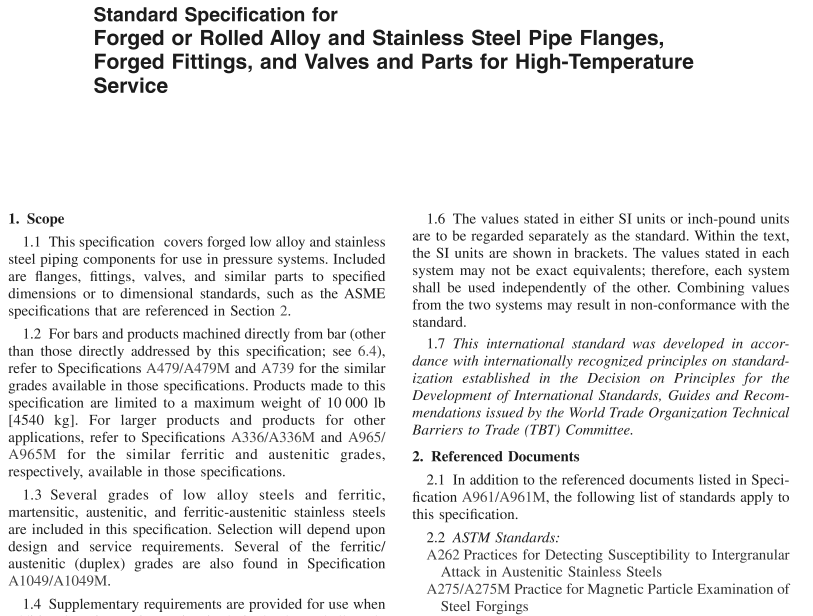ASME SA-182:2019 pdf free download SPECIFICATION FOR FORGED OR ROLLED ALLOY AND STAINLESS STEEL PIPE FLANGES, FORGED FITTINGS, AND VALVES AND PARTS FOR HIGH-TEMPERATURE SERVICE
7.Heat ‘Treatment
7.1 After hot working,forgings shall be cooled to a tem-perature below 1000 F[538 Cprior to heat treating inaccordance with the requirements of Table 1.
7.2 Low Alloy Steels and Ferritic and Martensitic StainlessSteels—The low alloy steels and ferritic and martensiticstainless steels shall be heat treated in accordance with therequirements of 7.1 and Table 1. When more than one heattreatment option is listed for a Grade in Table 1, any one of theheat treatments listed shall be performed.The selection of theheat treatment shall be at the manufacturer’s option,unlessotherwise stated in the purchase order.
7.2.1 Liquid Quenching——Except as permitted in 7.2.2,forF 1,F 2, and F 3,and when agreed to by the purchaser,liquidquenching followed by tempering shall be permitted providedthe temperatures in Table 1 for each grade are used.
7.2.1.1 Marking—Parts that are liquid quenched and tem-pered shall be marked”QT”
7.2.2 Alternatively,Grade F 1,F 2, and F 12,Classes 1 and2 may be given a heat treatment of 1200 °F[650 °C] minimumafter final hot or cold forming.
7.3 Austenific and Ferritic-Austenitic Stainless Steels—Except as permitted by 7.5, the austenitic and ferritic-austeniticstainless steels shall be heat treated and liquid-quenched inaccordance with the requirements of 7.1 and Table 1.
7.3.1 Alternatively,immediately following hot working,.while the temperature of the forging is not less than theminimum solution annealing temperature specified in Table l,forgings made from austenitic grades (except grades F 304H, F309H,F 310,F 310H,F 316H,F316Ti,F 321,F 321H,F 347,F347H,F 348,F 348H,F 45,and F 56) may be individuallyrapidly quenched in accordance with the requirements of Table.1.Ferritic-austenitic grades may be solution annealed withoutcooling below 1000F by being re-heated to the solutionannealing temperature required in Table 1,held for a timesufficient to dissolve phases and precipitates which may causeareduction in corrosion or mechanical properties,andquenched in accordance with Table 1.
7.3.2 See Supplementary Requirement s8 if a particularheat treatment method is to be employed.
7.4 Time of Heat Treatment—Heat treatment of forgingsmay be performed before machining.
7.5 Forged or Rolled Bar—Forged or rolled austeniticstainless bar from which cylindrically shaped parts are to bemachined, as permitted by 6.4,and the parts machined fromsuch bar,without heat treatment after machining,shall befurnished to the annealing and quenching or rapid-coolingrequirements of SpecificationA4847A484Mor thisspecification, with subsequent light cold drawing and straight-ening permitted (see Supplementary Requirement S3 if anneal
8. Chemical Composition
8.1 A chemical heat analysis in accordance with Specifica- tion A961/A961M shall be made and conform to the chemical composition prescribed in Table 2.
8.2 Grades to which lead, selenium, or other elements are added for the purpose of rendering the material free-machining shall not be used.
8.3 Starting material produced to a specification that spe- cifically requires the addition of any element beyond those listed in Table 2 for the applicable grade of material is not permitted.
8.4 Steel grades covered in this specification shall not contain an unspecified element, other than nitrogen in stainless steels, for the ordered grade to the extent that the steel conforms to the requirements of another grade for which that element is a specified element having a required minimum content. For this requirement, a grade is defined as an alloy described individually and identified by its own UNS designa- tion or Grade designation and identification symbol in Table 2.
8.5 Product Analysis—The purchaser may make a product analysis on products supplied to this specification in accor- dance with Specification A961/A961M.
9. Mechanical Properties
9.1 The material shall conform to the requirements as to mechanical properties for the grade ordered as listed in Table 3.
9.2 Mechanical test specimens shall be obtained from pro- duction forgings, or from separately forged test blanks pre- pared from the stock used to make the finished product. In either case, mechanical test specimens shall not be removed until after all heat treatment is complete. If repair welding is required, test specimens shall not be removed until after post-weld heat treatment is complete, except for ferritic grades when the post-weld heat treatment is conducted at least 50 °F [30 °C] below the actual tempering temperature. When test blanks are used, they shall receive approximately the same working as the finished product. The test blanks shall be heat treated with the finished product and shall approximate the maximum cross section of the forgings they represent.
9.3 For normalized and tempered, or quenched and tem- pered forgings, the central axis of the test specimen shall be taken at least 1 ⁄ 4 T from the nearest surface as-heat-treated, where T is the maximum heat-treated thickness of the repre- sented forging. In addition, for quenched and tempered forgings, the mid-length of the test specimen shall be at least T from all other surfaces as-heat-treated, exclusive of the T dimension surfaces. When the section thickness does not permit this positioning, the test specimen shall be positioned as near as possible to the prescribed location, as agreed to by the purchaser and the supplier.
ASME SA-182:2019 pdf free download
